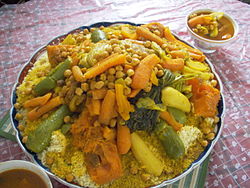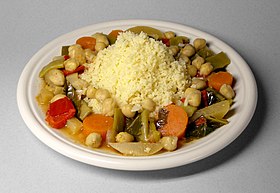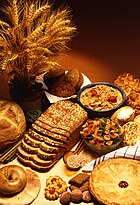Couscous
Couscous (pron.: /ˈkʊskʊs/ or /ˈkuːskuːs/) (Amazigh: seksu ) is a traditional Berber[1][2][3][4] dish of semolina traditionally served with a meat or vegetable stew spooned over it. Couscous is a staple food throughout Algeria, Morocco, Tunisia, and Libya.
Couscous was elected as the third favorite dish of French people in 2011 in a study by TNS Sofres for magazine Vie Pratique Gourmand and the first in East of France.[5][6]
Contents |
[edit] Etymology
The name is derived from Berber language (Berber:seksu (meaning well rolled, well formed, rounded). Numerous different names and pronunciations for couscous exist around the world. Couscous is /ˈkʊskʊs/ or /ˈkuːskuːs/ in the United Kingdom and only the latter in the United States. In Berber it is known as Seksu or Kesksu and in Arabic: كسكس pronounced Kuskus. It is also known as: taam (طعام) in Algeria,"Kseksu" or "Kesksu" in Morocco; Kuseksi-in Tunisia, Libya and Kuskusi (كسكسي) in Egypt. Keskesu in Tuareg.[7]
[edit] History
One of the first written references is from an anonymous 13th-century North Africa/Andalusian cookbook, Kitāb al-tabǐkh fǐ al-Maghrib (North Africa) wa'l-Andalus (Arabic) "The cookbook of the Maghreb and Al-Andalus", with a recipe for couscous that was 'known all over the world'. To this day, couscous is known as 'the North Africa national dish'.[8] Couscous was known to the Nasrid royalty in Granada as well. And in the 13th century a Syrian historian from Aleppo includes four references for couscous. These early mentions show that couscous spread rapidly, but generally that couscous was common from Tripolitania to the west, while from Cyrenaica to the east the main cuisine was Egyptian, with couscous as an occasional dish. Today, in Egypt and the Middle East, couscous is known, but in Algeria, Morocco, Tunisia and Libya couscous is a staple. Couscous was taken from Syria to Turkey in the 16th century and is eaten in most of the southern provinces.
Couscous is a traditional meal of the cuisine from Trapani. In Rome Bartolomeo Scappi's culinary guide of 1570 describes a Moorish dish, succussu; in Tuscany.[9]
One of the earliest references to couscous in France is in Brittany, in a letter dated January 12, 1699. But it made an earlier appearance in Provence, where the traveler Jean Jacques Bouchard wrote of eating it in Toulon in 1630. Couscous was originally made from millet.[10] Historians have different opinions as to when wheat began to replace the use of millet. The conversion seems to have occurred sometime in the 20th century, although many regions continue to use the traditional millet. Couscous seems to have a North African origin. Archaeological evidence dating back to the 10th century, consisting of kitchen utensils needed to prepare this dish, has been found in this part of the world.
In some regions couscous is made from coarsely ground barley or pearl millet. In Brazil, the traditional couscous is made from cornmeal.[11]
[edit] Preparation
The semolina is sprinkled with water and rolled with the hands to form small pellets, sprinkled with dry flour to keep them separate, and then sieved. Any pellets which are too small to be finished granules of couscous and fall through the sieve will be again rolled and sprinkled with dry semolina and rolled into pellets. This process continues until all the semolina has been formed into tiny granules of couscous. This process is very labour-intensive. In the traditional method of preparing couscous, groups of women would come together and make large batches over several days.[citation needed] These would then be dried in the sun and used for several months. Couscous was traditionally made from the hard part of the durum, the part of the grain that resisted the grinding of the relatively primitive millstone. In modern times, couscous production is largely mechanized, and the product is sold in markets around the world.
In the Sahelian countries of West Africa, such as Mali and Senegal, pearl millet is pounded or milled to the size and consistency necessary for the couscous.[12]

Properly cooked couscous is light and fluffy, not gummy or gritty. Traditionally, North Africans use a food steamer (called a كِسْكَس kiskas in Arabic or a couscoussière in French). The base is a tall metal pot shaped rather like an oil jar in which the meat and vegetables are cooked as a stew. On top of the base, a steamer sits where the couscous is cooked, absorbing the flavours from the stew. The lid to the steamer has holes around its edge so steam can escape. It is also possible to use a pot with a steamer insert. If the holes are too big the steamer can be lined with damp cheesecloth. There is little archaeological evidence of early diets including couscous, possibly because the original couscoussière was probably made from organic materials which could not survive extended exposure to the elements.
[edit] Instant couscous
The couscous that is sold in most Western supermarkets has been pre-steamed and dried, the package directions usually instruct to add 1.5 measures of boiling water or stock and butter to each measure of couscous and to cover tightly for 5 minutes. The couscous swells and within a few minutes it is ready to fluff with a fork and serve. Pre-steamed couscous takes less time to prepare than regular couscous, most dried pasta, or dried grains (such as rice).
[edit] Local variations
In Algeria, Morocco, Tunisia, and Libya couscous is generally served with vegetables (carrots, potatoes, turnips, etc.) cooked in a spicy or mild broth or stew, and some meat (generally, chicken, lamb or mutton).
In Algeria and Morocco it is also served, sometimes at the end of a meal or just by itself, as a delicacy called "seffa". The couscous is usually steamed several times until it is very fluffy and pale in color. It is then sprinkled with almonds, cinnamon and sugar. Traditionally, this dessert will be served with milk perfumed with orange flower water, or it can be served plain with buttermilk in a bowl as a cold light soup for supper.
In Libya, it is mostly served with meat, specifically beef, lamb, or camel, in Tripoli and the western parts of Libya, but not during official ceremonies or weddings. Another way to eat couscous is as a dessert; it is prepared with dates, sesame, and pure honey, and locally referred to as "maghrood".
In Tunisia, it is made mostly spicy with harissa sauce, it is served with almost everything, including lamb, beef, camel, and poultry. Fish couscous is Tunisian specialty, it can be also made with octopus in hot red spicy sauce. Couscous in Tunisia is served on every occasion; it is also served sweetened as dessert called masfouf, mostly during Ramadan.
In Egypt, couscous is eaten more as a dessert. It is prepared with butter, sugar, cinnamon, raisins, nuts and topped with cream.
Couscous is also very popular in France, where it is now considered a traditional dish, and has also become popular in Spain, Portugal, Italy, and Greece. Indeed, many polls have indicated that it is often a favorite dish.[13] Although introduced in France by the pieds noirs (people of European descent who used to live in Algeria), many couscous restaurants are now owned by people originating from Algeria. In France, Spain, Italy, and Portugal, the word "couscous" (cuscús in Spanish, Portuguese, and Italian) usually refers to couscous together with the stew. Packaged sets containing a box of quick-preparation couscous and a can of vegetables and, generally, meat are sold in French, Spanish, Italian, and Portuguese grocery stores and supermarkets. In France, it is generally served with harissa sauce.
In North America, Australia, and the United Kingdom, couscous is available most commonly as either plain or pre-flavoured, quick preparation boxes. In the United States, it is widely available, normally found in the ethnic or health-food section of larger grocery stores.
There are recipes from Brazil and other Latin American countries that use boiled couscous molded into a timbale with other ingredients. In Northeastern Brazil and among the diaspora of its population in other Brazilian regions, cuzcuz (Portuguese pronunciation: [kusˈkus] locally, kuʃˈkujʃ in Rio de Janeiro, kujsˈkujs in São Paulo), a steamed cake of couscous and corn flour (a mixture called fubá, pronounced Portuguese pronunciation: [fuˈba], said to be of African origin from the slave trade), is a popular meal, served in many forms: With sugar and milk, with varied meats, with cheese and eggs, and so on. In Mexico, there are two dishes called the couscous taco (taco de cuscús) and couscous burrito (burrito de cuscús), which consists of the addition of couscous to a traditional taco or burrito respectively, similar in fashion to a North African pita.
[edit] Nutrition
| Serving size 1 cup (173 g) | |||
| Servings per container Information is per dry couscous as determined by Nutrient Data Laboratory, ARS, USDA.[14] | |||
| Amount per serving | |||
| Calories 176 | Calories from fat 2 | ||
| % Daily value* | |||
| Total fat 0.25 g | 0% | ||
| Saturated fat 0.05 g | 0% | ||
| Trans fat 0 g | |||
| Cholesterol 0 mg | 0% | ||
| Sodium 17 mg | 1% | ||
| Potassium 79 mg | 2% | ||
| Total carbohydrate 36 g | 12% | ||
| Dietary fiber 2 g | 1% | ||
| Sugars 0 g | |||
| Protein 6 g | |||
| Vitamin A | 0% | Vitamin C | 0% |
| Calcium | 1% | Iron | 2% |
| *Percent daily values are based on a 2,000‑calorie diet. Your daily values may be higher or lower depending on your calorie needs. | |||
Couscous is among the healthiest grain-based products. It has a glycemic load per gram 25% below that of pasta. It has a superior vitamin profile to pasta, containing twice as much riboflavin, niacin, vitamin B6, and folate, and containing four times as much thiamine and pantothenic acid.[15][16][17]
In terms of protein, couscous has 3.6 g for every 100 calories, equivalent to pasta, and well above the 2.6 g for every 100 calories of white rice. Furthermore, couscous contains a 1% fat-to-calorie ratio, compared to 3% for white rice, 5% for pasta, and 11.3% for rice pilaf.[18]
[edit] Similar products
- Attiéké, a variety of couscous that is a staple food in Côte d'Ivoire and is also known to surrounding areas of West Africa, made from grated cassava.
- Wassa wassa, is another variety of couscous made in northern Togo made from yams.
- Berkoukesh are pasta bullets made by the same process, but are larger than the grains of couscous.
- Fregula, a pasta from Sardinia, consists of pellets that are larger than couscous and toasted.
- Kouskousaki (Κουσκουσάκι in Greek or Kuskus in Turkish), a pasta from Greece and Turkey, that is boiled and served with cheese and walnuts.
- In Brazilian cuisine, the "cuscuz marroquino" is a version, usually eaten cold, of the "couscous". Brazilian cuscuz is usually made out of corn meal, rather than semolina wheat. Another festive moulded couscous dish, containing chicken, vegetables, spices, steamed in a mould and decorated with orange slices is called "Cuscuz de Galinha".
- In Lebanese cuisine, Jordanian cuisine and Palestinian cuisine, a similar but larger product is known as maftoul or moghrabieh.
- "Israeli couscous" (in Hebrew פתיתים 'flakes' ), also called "ptitim", is a larger, baked wheat product similar to the Italian orzo.[19]
[edit] See also
[edit] References
- ^ Tunisia's most famous dish: Couscous tunisialive - Retrieved January 23, 2013.
- ^ COUSCOUS (FROM MOROCCO) By VahRehVah - Retrieved January 23, 2013.
- ^ Crazy for Couscous! Couscous a High Protein, Versatile Pasta-ish Food - Retrieved January 23, 2013.
- ^ Couscous the highlight of themed dinner allmediascotland.com - Retrieved January 23, 2013.
- ^ Les plats préférés des Français, enquête réalisée en août 2011 pour le magazine Vie Pratique Gourmand auprès d'un échantillon national de 999 personnes représentatif de l'ensemble de la population âgée de 18 ans et plus, interrogées en face à face. Méthode des quotas (sexe, âge, profession du chef de ménage PCS) et stratification par région et catégorie d’agglomération.
- ^ Magret is the No1 dish for French
- ^ FOUCAULD Charles de : Dictionnaire touareg-français, Paris, Imprimerie Nationale, 1950–52, p. 919
- ^ 'Traditional North Africa Cooking, by Madame Guinaudeau. p.81. ISBN 1-897959-43-5
- ^ John Dickie, Delizia! The Epic History of the Italians and Their Food (New York, 2008) pp. 15, 115, 264f.
- ^ See numerous books describing couscous as boiled millet: http://www.google.com/search?tbo=p&tbm=bks&q=millet+couscous&tbs=,cdr:1,cd_min:Jan%203_2%201,cd_max:Dec%2031_2%201922&num=10#q=millet+couscous&hl=en&tbs=bks:1,cdr:1,cd_min:Jan+3_2+1,cd_max:Dec+31_2+1922&ei=vGxCTdLYEcPbgQeFnc2JAg&start=0&sa=N&fp=64aa18c4243f0c16
- ^ Receitas
- ^ Sivak MN. Starch: Basic Science to Biotechnology. Academic Press, 1998, ISBN 0-12-016441-8, p. 132
- ^ "Notre Temps" Study conducted on January 11 and 12, 2006 for the magazine Notre Temps based on face-to-face interviews with a sample of 1,000 people representative of the adult French population, stratified by age, sex, profession of the head of household, region and type of municipality.
- ^ Couscous, dry – NDB No: 20028 United States Department of Agriculture National Nutrient Database for Standard Reference. Retrieved December 18, 2007.
- ^ "Couscous, cooked". self.com – Nutrition Data. http://www.nutritiondata.com/facts/cereal-grains-and-pasta/5699/2. Retrieved September 20, 2010.
- ^ "Spaghetti, cooked, unenriched, without added salt". self.com – Nutrition Data. http://www.nutritiondata.com/facts/cereal-grains-and-pasta/5810/2. Retrieved September 19, 2010.
- ^ "Rice, white, long-grained, parboiled, unenriched, cooked". self.com – Nutrition Data. http://www.nutritiondata.com/facts/cereal-grains-and-pasta/5815/2. Retrieved September 19, 2010.
- ^ "Calories in Rice Pilaf". LIVESTRONG.COM – Nutrition Facts, and Healthy Alternatives. http://www.thedailyplate.com/nutrition-calories/food/generic/rice-pilaf. Retrieved September 19, 2010.
- ^ The Canadian Living Test Kitchen. "Discover Couscous". Canadian Living Magazine. http://www.canadianliving.com/food/cooking_school/discover_couscous.php.
[edit] External links
| Wikibooks Cookbook has a recipe/module on |
| Wikimedia Commons has media related to: Couscous |
- BBC Food Glossary: Couscous
- Mediterranean and World Cuisine: Couscous: History of Couscous by Clifford A. Wright
- Saudi Aramco World article on Couscous: Couscous — The Measure of the Maghrib. Written by Greg Noakes and Laidia Chouat Noakes 1998.
- Magharebia.com: News and Views of the Maghreb article on Couscous: Couscous: Long-Term Maghreb Staple Still Going Strong
|
|||||||||||||||||||||||||||||||||||
|
||||||||||||||



